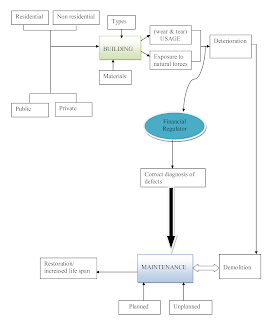MAINTENANCE OF BUILDINGS OF PUBLIC INSTITUTIONS.
 |
| National Theatre, Accra-Ghana |
Researcher: P. J. C.
Main Objective
To evaluate the building maintenance
practices being employed in public institutions and its effect on the structure
as the users of the building.
Rationale
Many Ghanaian public structures are often
inadequately maintained and windows and doors and other building elements and
facilities frequently show evidence of lack of maintenance and
repair. Some residential and office buildings of public institutions have
not seen any significant maintenance or show little signs of maintenance since
they were constructed, some dating back to the colonial era.
Ad: We offer a range of writing and research services. Find out more!
Ad: We offer a range of writing and research services. Find out more!
Key Findings
The study has established that housing
maintenance is a real problem among public institutions in Ghana, with about 83
percent of all residential buildings of public institutions surveyed having
maintenance problems. Maintenance problem is more prominent in Ghana Police
Service (GPS) and University of Education, Winneba - Kumasi Campus (UEW-K)
with 41.2 % and 30.8 % of their buildings in a bad condition, with 14.3
percent of those of Ghana Health Service (GHS) in the same situation
Fig 1: Conceptual Framework for Maintenance of Building
Abstract
A building fabric is referred to as an
“environmental envelope” because it is the means by which the natural or
external environment may be modified, to produce a satisfactory internal
environment for man to live in. The deterioration of buildings hampers its
ability to perform adequately, thus is important to ensure proper maintenance
to prevent deterioration.
Public buildings represent significant
investment of the tax payers’ money and therefore preserving these building
systems is important. Due to the neglect of the maintenance component of the
housing process in the country, a lot of public and private residential buildings
are in a state of disrepair.
In view of the above, this study was
designed to assess the current condition of public buildings, identify the
underlying principal causes of poor maintenance of public buildings, analyse
the maintenance policy and practice and capacity of the maintenance and estate
departments of public institutions and make suggestions and recommendations
towards the adoption of effective maintenance policy and innovations that would
address the building maintenance problem in public institutions.
The field investigations focused on
residential buildings of GPS, GHS nurses quarters and UEW-K. Three different
housing types were defined for data collection and analyses including:
bungalows, tenement houses and single unit houses. Through the application of
multi-stage cluster sampling and purposive and random sampling techniques, 176
buildings were covered in the survey. The survey revealed that there is a real
housing maintenance problem in public institutions in Ghana. The study revealed
that on the whole, 83 percent of all residential buildings of public
institutions surveyed have maintenance problems with maintenance problem being
more prominent in GPS and UEW-K with 41.2 percent and 30.8 percent of their
buildings in a bad condition, with 14.3 percent of those of GHS in the same
situation.
Maintenance problems by housing types in
public institution revealed that building maintenance problems are more
pronounced in single unit houses than tenement houses and bungalows with 48.4
percent, 37.5 percent and 5 percent respectively in bad condition. However,
tenement houses had the highest buildings with good condition, with 37.5
percent of all tenement houses surveyed in good condition requiring the least
or no maintenance.
The study also established the following
factors as being responsible for the poor maintenance of public buildings: The
age of the buildings, Lack of maintenance culture, Inadequate funds and high
maintenance cost, Pressure on building facilities by number of users and Poor
construction work and maintenance work done by maintenance personnel of the
institution. Stakeholders in the housing sector also added to the problem has
arisen as a result of lack of preventive maintenance plan, low capacity of
maintenance personnel in terms of staffing and training, absence of a national
maintenance policy and apathy and lack of patriotism on the part of some public
employees occupying government bungalows.
The study concludes by enumerating a
number of recommendations aimed at providing the necessary framework for proper
and effective maintenance of buildings. These are: the need for public
institutions to embrace preventive maintenance practice as a high priority
rather than adhoc maintenance. Managers are to oversee periodic inspections of
buildings’ conditions and create an inventory of buildings’ components and
equipment. Public institutions should ensure that their maintenance department
is adequately staffed. There is also the need for a national policy on
maintenance to be formulated to protect buildings, institution of a maintenance
awards scheme for public institutions and establishing a maintenance fund to be
managed for maintenance of public buildings in the country.
Some References
Afranie, S and Osei Tutu, E. (1999). Analyzing
of Problems, Practices and Policy.
Black, J.A. and Champion, D.J. (1976).
Methods and Issues in Social Research.
New York, John
British Standards Institution. BS 3811:
1984 Glossary of Maintenance Management Terms in Terotechnology Chicago: APWA,
1992.
Cohen, L. (1976). Educational Research in
Classrooms and Schools: A Manual of Materials and Methods. London: Harper
& Row. Collins English Dictionary, 2003
Derek Miles and Paul Syagga, (1987),
Building Maintenance, Intermediate
Technology. London Dictionary of Military
and Associated Terms, US Department of Defense, 2005
Flyvbjerg, B. (2004). Five
Misunderstandings about Case-Study Research. In Seale. C., Gobo,
Gubrium G, J.F. & Silverman, D. [Eds],
Qualitative Research Practice. London and Thousand Oaks, CA: Sage p. 420-434
Frankfort-Nachmias, C. and Nachmias, D.
(1996). Research Methods in the Social Sciences (5th Edition). Oxford University
Press, New York.
http://www.oas.org\en\cdmp accessed on 12 February
2010
http://www.ghanaweb.com accessed on 24
October 2010
Kothari, C.R, (2003), Research
Methodology-Quantitative Techniques for
Managerial Decisions. Wiley Eastern
Limited, U.K
Kumar, R. (1999). Research Methodology: A
Step by Step Guide for Beginners.
Australia, Addison Wesley Longman,
Australia Ply Limited.


.webp)







No comments: